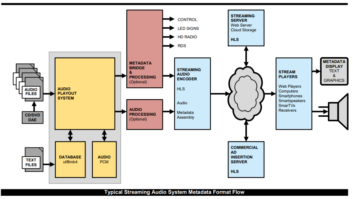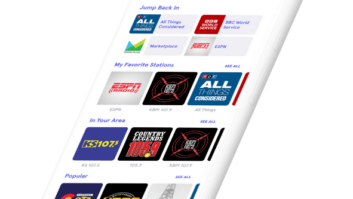Ad-Insertion Patent Could Further Muddy Future of Internet Streaming
DENVER Two Colorado businessmen say they have patented the ad-insertion process that allows radio broadcasters to substitute content from their terrestrial signal with alternate material for their Web streams. The pair intends to seek non-exclusive licensing agreements to use the process.
For terrestrial radio broadcasters looking to continue or resume streaming their programming online, observers say, the new patent could be yet another financial constraint. According to one estimate, 1,800 radio stations in the United States are streaming. It’s unclear how many of those use ad insertion.
The patent, issued by the U.S. Patent and Trademark Office in June to business partners David Minter and Al Baldocchi, covers the real-time removal of content in an Internet radio broadcast.
At least two companies that offer ad-insertion products said they had yet to be contacted by the patent holders.
Replacing local ads
According to the patent, “The invention is directed to the replacement of the portion of the content in a radio station broadcast that is distributed over the Internet that is local in nature or otherwise unsuitable for the Internet audience with content that is relevant to the broader audience that is capable of receiving the Internet broadcast.”
Minter and Baldocchi say they applied for the “Internet Radio System With Selective Replacement Capability” patent in 1999 when both were searching for opportunities to start a consumer-oriented radio Web site, which they later abandoned.
“However, our business model for Internet radio was centered around ad-insertion capability,” Minter said. “This was before anyone else was doing ad insertion. We realized that eventually ad insertion was going to be the economic engine to drive Internet radio.”
Minter is president of Minter and Associates, a consulting practice that specializes in the entertainment industry, based in Denver. Baldocchi is an independent consultant and investment banker in Boulder.
They said they researched the ad-insertion process with the help of an intellectual property attorney and determined at the time that no one else owned the idea of ad insertion.
Baldocchi said the technology behind the patent is fairly simple and does not depend on any specific software or hardware.
“Very simply, the technology calls for searching a radio broadcast for some type of marker, such as a tone or digital marker, and inserting at that point alternate content in real time, as the broadcast is streamed over the Internet,” Baldocchi said.
Baldocchi said the ad-insertion processes covered under the patent are in limited use. “We want to work with those companies to develop rational and equitable licensing agreements,” he said.
That includes broadcasters and suppliers, Baldocchi said.
“Our customer will be anyone using ad insertion or selling the capability to another party. Any broadcaster who is using third — party software with ad — insertion capability should insure themselves that they are either not using our technology, or are appropriately licensed,” Baldocchi said. “The patent applies to any terrestrial broadcaster looking to repurpose audio for the Internet.
“Broadcasters who are using their own ad-insertion software that employs our process will be expected to license that technology through us,” he said. “Broadcasters using third-party software licensed for the technology will not be asked to pay any additional licensing fee.”
No licensing agreements are in place yet, Minter said, though he and Baldocchi have a number of ongoing conversations with certain companies. “There are a lot of people we have yet to even contact. We are not releasing any information on prospects, fees or negotiations at this time,” Minter said.
Officials with RCS and Lightningcast Inc., two companies that offer ad-insertion products, said they had not been contacted by the patent holders and declined further comment.
Minter said the pair’s approach to pricing the non — exclusive licensing fee will be to keep it reasonable as to not discourage growth in the ad — insertion business.
“Internet radio is in its infancy and we don’t want to get in the way of its development. But we still have to realize value for our patent,” Minter said. “The growth potential is still there with the RIAA (Recording Industry Association of America) stuff seemingly resolved. That coupled with the growth of broadband …We see a fire lit under Internet radio again.”
Using the ad-insertion process allows broadcasters to replace local commercials with material that would be more suitable for an audience over a wider geographical area, Minter said.
“For example, a broadcaster in Denver can swap out a local car dealership ad with an ad for Amazon or Coca Cola, or another national advertiser in their Internet stream,” Minter said.
Additional licensing fees could add to broadcasters’ concern over streaming costs and other expenses tied to Internet programming, analysts say.
“I would think it could be a barrier to some broadcasters,” said George Bundy, CEO of BRS Media, an Internet consulting firm that consults broadcasters in the areas of audio streaming and Web site management.
“However, I would think that as the ad-insertion business matures and becomes an additional revenue source for broadcasters, that any streaming fees would be seen as minimal.”
Bundy estimates from his research that a total of 1,800 commercial and non-commercial radio stations in the United States are streaming on the Internet.
Ad insertion came to the forefront in 2001 when many large-market radio stations ceased their Web streams over concerns voiced by the American Federation of Television and Radio Artists about additional talent fees due their members for a second use of the copyrighted recorded material, Bundy said.
Still to be determined is whether broadcasters would have to pay retroactive fees to record companies and artists, as a result of their Web streams, under provisions of the Digital Millennium Copyright Act of 1998.
In October, the 3rd U.S. Circuit Court of Appeals in Philadelphia rejected an appeal filed by the NAB and several radio group owners seeking an exemption from paying digital sound recording copyright fees under the DMCA and the Digital Performance Right in Sound Recordings Act of 1995.











